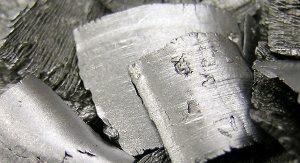Hafnium
Hafnium is used in filaments and electrodes. Some semiconductor fabrication processes use its oxide for integrated circuits at 45 nm and smaller feature lengths. Some superalloys used for special applications contain hafnium in combination with niobium, titanium, or tungsten.
Hafnium's large neutron capture cross-section makes it a good material for neutron absorption in control rods in nuclear power plants, but at the same time requires that it be removed from the neutron-transparent corrosion-resistant zirconium alloys used in nuclear reactors.
Production
The heavy mineral sands ore deposits of the titanium ores ilmenite and rutile yield most of the mined zirconium, and therefore also most of the hafnium.
Zirconium is a good nuclear fuel-rod cladding metal, with the desirable properties of a very low neutron capture cross-section and good chemical stability at high temperatures. However, because of hafnium's neutron-absorbing properties, hafnium impurities in zirconium would cause it to be far less useful for nuclear-reactor applications. Thus, a nearly complete separation of zirconium and hafnium is necessary for their use in nuclear power. The production of hafnium-free zirconium is the main source for hafnium.
A lump of hafnium which has been oxidized on one side and exhibits thin film optical effects.
The chemical properties of hafnium and zirconium are nearly identical, which makes the two difficult to separate. The methods first used — fractional crystallization of ammonium fluoride salts or the fractionated distillation of the chloride — have not proven suitable for an industrial-scale production. After zirconium was chosen as material for nuclear reactor programs in the 1940s, a separation method had to be developed. Liquid-liquid extraction processes with a wide variety of solvents were developed and are still used for the production of hafnium. About half of all hafnium metal manufactured is produced as a by-product of zirconium refinement. The end product of the separation is hafnium(IV) chloride. The purified hafnium(IV) chloride is converted to the metal by reduction with magnesium or sodium, as in the Kroll process.
HfCl4 + 2 Mg (1100 °C) → 2 MgCl2 + Hf
Further purification is effected by a chemical transport reaction developed by Arkel and de Boer: In a closed vessel, hafnium reacts with iodine at temperatures of 500 °C, forming hafnium(IV) iodide; at a tungsten filament of 1700 °C the reverse reaction happens, and the iodine and hafnium are set free. The hafnium forms a solid coating at the tungsten filament, and the iodine can react with additional hafnium, resulting in a steady turn over.
Hf + 2 I2 (500 °C) → HfI4
HfI4 (1700 °C) → Hf + 2 I2
| Symbol | Hf | |
| Atomic Number | 72 | |
| Atomic Weight | 178.49 | |
| Oxidation States | +4 | |
| Electronegativity, Pauling | 1.5 | |
| State at RT | solid | |
| Melting Point, K | 2503 | |
| Boiling Point, K | 5470 |
Harmful effects:
Hafnium is considered to be non-toxic. In powdered form it is pyrophoric (can ignite spontaneously).
Characteristics:
- Hafnium is a lustrous, silvery, ductile metal.
- Chemically it is similar to zirconium.
- When present in compounds, hafnium exists mostly in the oxidation state IV.
- Hafnium resists corrosion due to the formation of an oxide film on exposed surfaces.
- It is unaffected by all acids (apart from hydrogen fluoride) and all alkalis.
- Hafnium reacts with the halogens to form tetrahalides, and at high temperatures it reacts with carbon, boron, nitrogen, oxygen, silicon and sulfur.
Uses of Hafnium
- Hafnium is used for nuclear reactor control rods because of its ability to absorb neutrons and its good mechanical and corrosion resistance qualities. This is in complete contrast to zirconium, which although is chemically is very similar to hafnium, is very poor at absorbing neutrons. Zirconium is therefore used in the cladding (outer layer) of fuel rods through which it is important that neutrons can travel easily.
- Hafnium is also used in photographic flash bulbs, light bulb filaments, and in electronic equipment as cathodes and capacitors.
- Hafnium alloys with several other metals, such as iron, niobium, tantalum and titanium.
- Hafnium-niobium alloys, for example, are heat resistant and are used in aerospace applications, such as space rocket engines.
- Hafnium carbide is used to line high temperature furnaces / kilns due to its refractory properties (it does not melt at high temperatures).
- Hafnium-based compounds are used in gate insulators in the 45 nm generation of integrated circuits for computers.
- Hafnium oxide-based compounds are being introduced into silicon-based chips to produce smaller, more energy efficient and performance packed processors
